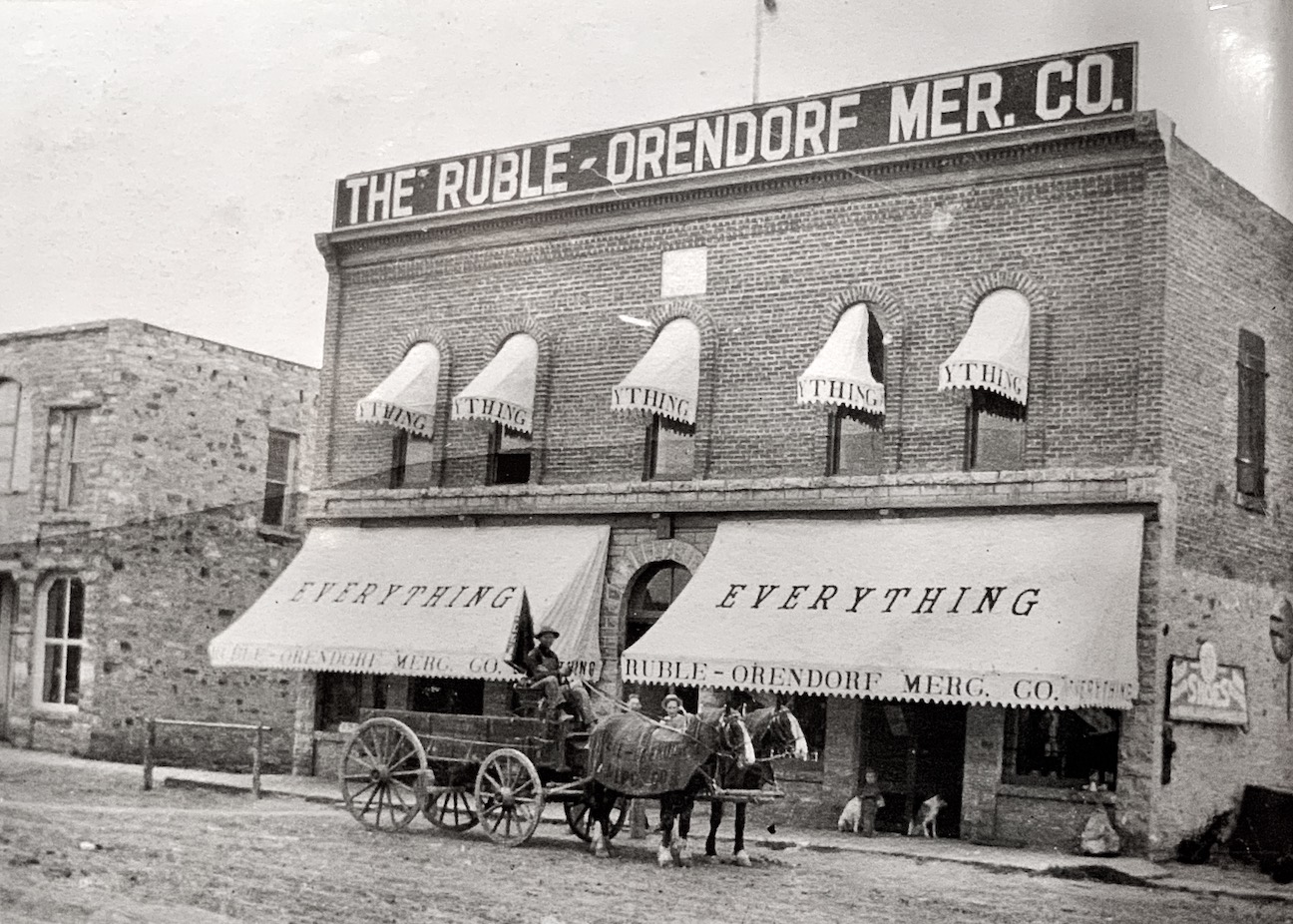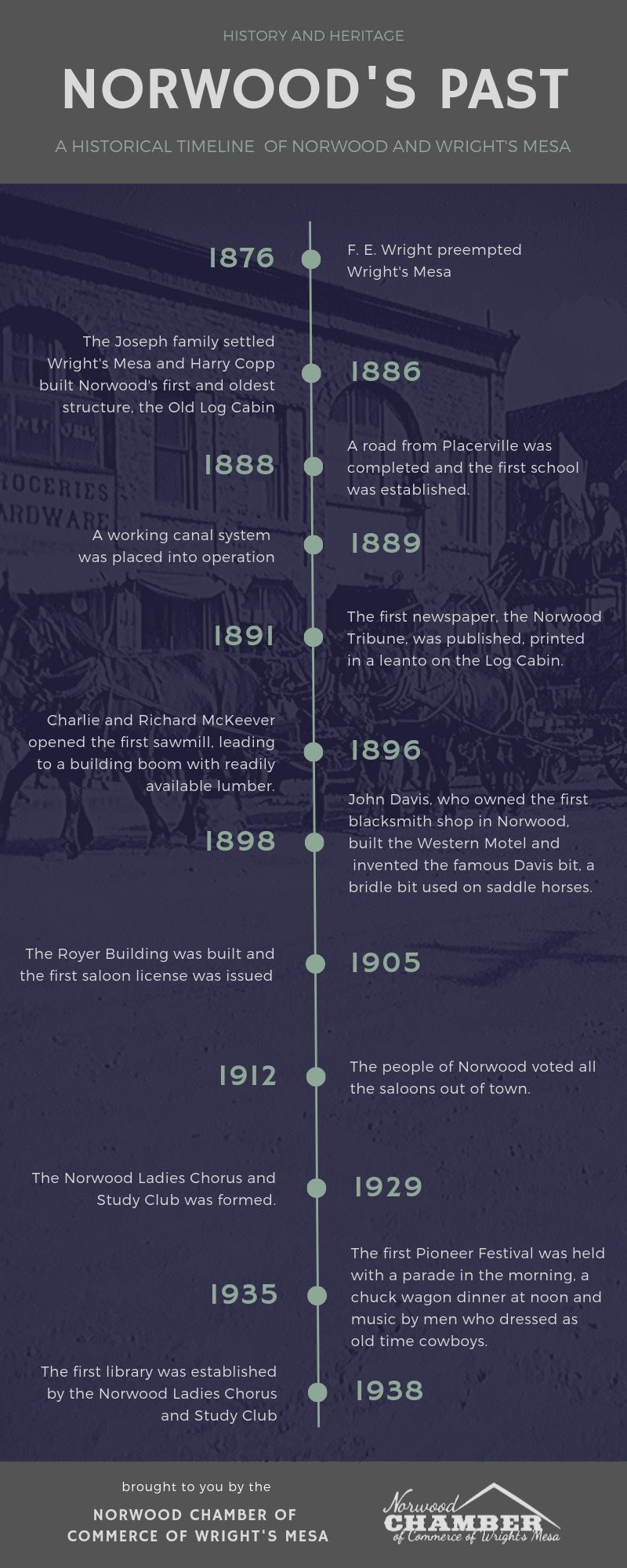History of Wright’s Mesa and Norwood, Colorado
Since Wright’s Mesa was discovered by miners traveling from Telluride in the late 1800s, ranching and agricultural heritage have continued to run deep in the lives of Norwood’s residents. The Ute Indians were the original settlers of the area known as Wright’s Mesa. For thousands of years the Utes utilized this fruitful mesa for camping, fishing and hunting and gathering. Accounts of this area contained in the Hayden Survey of 1876 described a spectacular valley with wide, clear flowing grasslands, surrounding the valleys, stretching for miles.
Legend has it that in 1877, two placer miners, working their way down the San Miguel River from Telluride, staking placer claims and looking for deposits of gold in the river, climbed out of the canyon one day to see what the country looked like above. What they saw was grassland. From the rim of the canyon they could see all the way to Utah and the vast grassland in front of them extended to the horizon. After looking the area over, the two miners went back to their home camp at the Keokuk placer camp near Saltado Canyon and likely reported to the other members of their party what they had seen. Word soon spread about this huge area of unclaimed, unused area of grassland.
How Wright’s Mesa became, Wright’s Mesa
A man by the name of F. E. Wright came upon the mesa that had been discovered by the aforementioned prospectors and saw a wonderful opportunity in front of him for ranching raising cattle. Wright located his desired piece of land and soon traveled to Lake City to file with the Land Office.
The Hayden Survey had marked all of the area on the mesa into townships and sections. Wright was thus able to find the numbers of the parcels that he wanted and preempted on 80 acres, at about the middle of the western edge of the mesa. In addition, he preempted another 80 acres up toward the southern end of the mesa where there was an extremely good spring, one of the finest in the entire country, which flowed a dandy stream of water year round.
A preemption was the name of the transaction when making a claim in Native American land. The cost to preempt was $1.25 per acre with $1.00 going to the Native Americans and $0.25 to the Government.
Before F. E. Wright had the opportunity to complete his filing by building a cabin and fencing in the are on the second 80 acres, a man by the name of Edwin Joseph came on to scene. Joseph operated a weigh station at the foot of Keystone Hill near Telluride and, like many others, may have heard rumors of the promise of the area on the mesa to the west. Riding from his weigh station, possibly looking for some land to settle and farm, he met up with F. E. Wright. Taken with the second 80-acre parcel with the fine spring that Wright had chosen, Joseph offered to buy his preemption, which Wright accepted, and sold for $100.
The First Pioneer Family to Settle Wright’s Mesa
After Edwin Joseph purchased Wright’s preemption, he went back to Telluride, where he continued to operate his weigh station. During that time, he traveled back and forth from Telluride to Wright’s Mesa and built a cabin on the 80-acre parcel with the spring where he later relocated his family. There was no road then, only a cow trail from Placerville that followed the San Miguel River. The morning the Josephs left Placerville it was 10 degrees below zero. They crossed the river at Specie Creek, traveled across Specie Mesa and arrived on Wright’s Mesa by pack train, and in 1886, the Joseph family became the first pioneer family to settle on Wright’s Mesa.
At the time Wright preempted his land, the only other settlers known to be living anywhere near the area were the Goshorn Family and a couple by the name of Mr. & Mrs. Tozer. Their sole reason for living there was to maintain a herd of saddle horses for the mail carriers who, at that time, brought mail from Ouray, Colorado to Richardson, Utah. The mail route from Ouray to Wright’s Mesa went through a large area of mostly open land, just south of the rim of the San Miguel River. When there was mail for Wright or Joseph, the carrier would place the mail in a sack and hang it on a tree or a landmark stump. Later on, the mail carrier constructed a sturdier container that secured it from birds, predators and weather. This is how this area became known as Mailbox Park.

The History of Norwood
A pioneer by the name of Harry Copp came to Wright’s Mesa in the spring of 1885 and filed on the land that had been surveyed and added out by Charles Wheeler. He named his new home Norwood, Colorado after his hometown in Missouri. Harry Copp became the first mayor of Norwood as well as the first postmaster.
The Old Log Cabin


Harry Copp built the first structure in Norwood in 1886 which housed the Post Office, General Store and was the only place to take care of overnight visitors to the area. The Log Cabin as it became known, was located on Grand Avenue next to the building that is currently Ace Hardware. In 1939 it was relocated by the Norwood Ladies Chorus and Study Club to its current site on Lucerne Street next to the former Lone Cone Library. The The Log Cabin is the oldest building in Norwood and is home to Norwood’s Historical Museum.
In 1887, W. H. Nelson was given the contract to build a road in San Miguel Canyon. Nelson put in a bridge across the San Miguel River and in 1888, completed a road that topped out east of the newly formed town of Norwood. By 1989, there was a working canal system in operation, furnishing water to a vast majority of people on the mesa. The State of Colorado advertised all over the world that they had “land and water for a price in beautiful San Miguel County.”
Wright’s Mesa was a perfect location to raise livestock with its vast grassland. Its comfortable climate and fertile soil made it an ideal location for farming as well. Norwood quickly became a main supplier of meat, produce, goods and lumber for those working in the mines of Telluride. Cowboys also loved to visit Norwood during their travels. There was liquor, gambling, prostitution and no law other than the County Sheriff. When cowboys left town, it was common to see them make their horses buck the full length of Main Street.

Norwood, A Town Of Firsts
Once word got out that there was now a road up to Wright’s Mesa, and that land and water were plentiful, people began pouring in by the dozens, taking up land and applying for water permits, faster than the present water supply would ever fulfill. The town of Norwood would soon have two hotels, three blacksmith shops, several liveries, three pool halls, two saloons, two general stores, a Post Office and a bank. There were a number of firsts for Norwood throughout its history:
- The first school which was established in 1888.
- The first newspaper, the Norwood Tribune, was published on March 19, 1891. The Norwood Tribune was printed in a leanto on the Log Cabin.
- In 1896, Charlie and Richard McKeever opened the first sawmill, which led to a building boom with lumber readily available.
- In 1898, John Davis built the Western Motel which was operated by Mrs. Royer for a few years. John Davis also owned the first blacksmith shop and invented the famous Davis bit, a bridle bit used on saddle horses.
- The first town ordinance to be passed prohibited the carrying of dangerous weapons within the town of Norwood, requiring all cowboys to check their guns and hunting knives at the livery or the town hall.
- The first saloon license was issued to John King in 1905.
- However, in 1912, the people of Norwood voted all the saloons out of town.
- On November 13, 1928, several ladies formed the Norwood Chorus club which objectives were: the improvement of themselves and the fostering and maintaining of a desirable community. In 1929 they voted to add a Study Club to the organization and later became the Norwood Federated Women’s Club.
- In 1935, the Norwood Ladies Chorus and Study Club acquired a stagecoach from the Telluride Transfer. The Stagecoach had been used in Telluride as a school bus and carried passengers from the train depot to hotels.
- The first Pioneer Festival was held in 1935. There was a parade in the morning, a chuck wagon dinner at noon and hillbilly music by men who arrived in a chuck wagon dressed as old time cowboys.
- The first library was established in 1938 by the Norwood Ladies Chorus and Study Club. Mr. and Mrs. Steve Herndon donated their homestead cabin to the club and it was moved from Oak Hill to its former location on Lucerne Street.
- In 1939, the Norwood Ladies Chorus and Study Club purchased the Log Cabin and moved it to its current location, next to the former library on Lucerne Street. The Log Cabin now serves as the Historical Museum for Norwood.
- Also in 1939, the Norwood Ladies Chorus and Study Club repaired and painted the stagecoach and debut it during the Pioneer Day Parade, where it continues to serve as a carriage for royalty and their families on Pioneer Day.







Text courtesy of Howard and Betty Greager, images courtesy of Wright’s Mesa Historical Society.